Joanne Hough
Geological Survey of South Australia, Department of State Development
Download this article as a PDF (904KB); cite as MESA Journal 81, pages 30–34
The Adelaide Hills International Sculpture Symposium Inc. (AHISS) is a community-based organisation that formed in 2011 to bring the arts to the Adelaide Hills by creating a Hills Sculpture Trail linking towns, art and beautiful scenery. Silvio Apponyi, internationally recognised sculptor, Adelaide Hills resident and artistic director, had a vision to ‘enrich the Hills with sculpture’.
Three biennial stone symposiums (Carving Dreams in Stone) held between 2012 and 2016, attracting internationally recognised sculptors from around the world, will culminate in 24 community-commissioned sculptures permanently located within the townships of the Adelaide Hills to form a sculpture trail (AHISS 2016).
The inaugural symposium was held 10–29 April 2012 and resulted in eight works (see article in MESA Journal 70:44–48). The second symposium was held 31 March to 21 April 2014 and the third on 4–6 April 2016. All symposiums were held at the ‘Cedars’, Hahndorf, the former home of Australian landscape artist Hans Heysen.
This article describes the 2014 sculptures and complements the earlier MESA Journal article (cited above) by Hough (2013).
The 2014 symposium sculptors originate from Finland, Georgia, Bulgaria, New Zealand, France, Australia and Turkey. A team of South Australian interns worked alongside these masters to help create the pieces.
The 2014 sculptures (sculptures 9–16) are located within the towns of Langhorne Creek, Mount Compass, Meadows, Stirling, Mount Barker, Little Hampton and Mount Torrens (Fig. 1).
The stones
Uniquely South Australian stones are the preferred choice for the sculptures. To date these have included pink and grey Paris Creek and Macclesfield marbles, white Angaston Marble, grey Kapunda Marble, mottled Sellicks Hill Marble, white Mount Torrens Marble and Black Granite (Black Hill Norite; Table 1; Fig. 1).
Stone used for the 2014 symposium was donated by Graham Arthy, Bert Davis, Barossa Quarries, Melocco Stone and Chesini House.
Sellicks Hill and Mount Torrens marbles are described below. For descriptions of the Paris Creek, Macclesfield, Angaston and Kapunda marbles and Black Hill Norite refer to Hough (2013).
Sellicks Hill Marble is referred to geologically as Fork Tree Limestone and is Early Cambrian in age. It is produced from Sellicks Hill Quarry (Private Mine 163), located about 50 km south of Adelaide on the Fleurieu Peninsula. The quarry commenced operations in the 1970s supplying aggregate to metropolitan Adelaide at around 1 Mtpa. The stone has also been utilised as rip rap and spalls, and for dimension stone for interior feature tiles for the hotel market. However, differential hardness between the carbonate and the mottled clay component created issues with polishing. The marble is predominantly black with an attractive gold mottling, and cream and tan in parts.
The historic Mount Torrens marble quarry was active in the early 1900s and reworked in the 1950s. Production was from an undifferentiated marble in the Early Cambrian Carrickalinga Head Formation. No production figures were recorded (Hiern 1957, 1959). The Mount Torrens Marble used for sculpture 16 was sourced from pond excavation works near the Mount Torrens quarry and adjacent to the Amy Gillett bikeway into Mount Torrens. The stone was acquired about 500 m before the end of the bikeway where it meets with Old Mount Road (off Oval Road). The marble is cream to white with buff and grey lenses and is similar in appearance to the Paris Creek and Macclesfield marbles.
Table 1 South Australian stones used for the Hills Sculpture Trail, 2012 and 2014 sculptures
| Stone | Source | Geological unit and age | Sculpture |
|---|---|---|---|
| Angaston Marble |
Bald Hill, Private Mine 112 |
Angaston Marble (Normanville Group; Early Cambrian) | 2 Sailing of Soul, 3 Prickly 3 (white prickle and base), 9 Flow (base) |
| Black Granite |
Black Hill, Mineral Lease 4383 |
Black Hill Norite (part of the Black Hill Gabbroic Complex; Early to Middle Ordovician) | 1 Spatial Tension, 5 Angel of Hahndorf, 6 Le Peloton, 8 The Remoteness, 10 Waterstone, 12 Journeys, 14 Cosmic Connections (sphere), 15 Splash, 16 The Key to the Heart of Mt Torrens and the Birdhouse (base) |
| Kapunda Marble |
Carrara Quarry, Private Mine 111 |
Kapunda Marble (Normanville Group; Early Cambrian) | 3 Prickly 3 (grey prickle) |
| Paris Creek Marble | Historic Paris Creek quarry south of Macclesfield |
Fork Tree Limestone (Normanville Group; Early Cambrian) | 4 Watersong, 7 Spring, Summer, Fall, Winter and …., 9 Flow, 11 Fossils |
| Macclesfield Marble | Historic Paris Creek 3 west of Macclesfield |
Undifferentiated Normanville Group (Early Cambrian) | 13 Hydris |
| Sellicks Hill Marble |
Sellicks Hill Quarry, Private Mine 163 |
Fork Tree Limestone (Normanville Group; Early Cambrian) | 14 Cosmic Connections |
| Mount Torrens Marble | Excavation works near the historic Mount Torrens marble quarry |
Carrickalinga Head Formation (Lower Kanmantoo Group; Early Cambrian) | 16 The Key to the Heart of Mt Torrens and the Birdhouse |
The sculptures
9 Flow
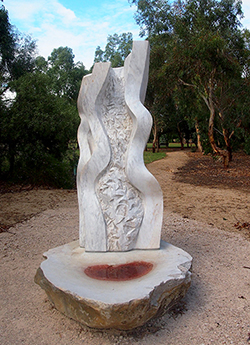 Sculptor: Agnessa Petrova, Bulgaria.
Sculptor: Agnessa Petrova, Bulgaria.
Stone: Paris Creek Marble completed in rough, honed and smooth finishes on a base of Angaston Marble.
Site: Alfred Langhorne Park, Langhorne Creek Road, Langhorne Creek.
Artist’s comment: ‘The energy and mystery of running water or wine and all the beautiful wavy shapes created are the subject of the composition. I tried to express the inspiration and the feeling of freedom or flight that is suggested by these shapes’. (Photo 415056)
10 Water Stone
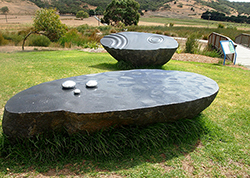 Sculptor: Hew Chee Fong, Australia.
Sculptor: Hew Chee Fong, Australia.
Stone: Black Granite. The polished top with stainless steel droplets is complemented by a rough underside to the base.
Site: Mount Compass Wetlands, Sam Court (off Nangkita Road), Mount Compass.
Artist’s comment: ‘Water, our most precious resource, it is life itself’. (Photo 415057)
11 Fossils
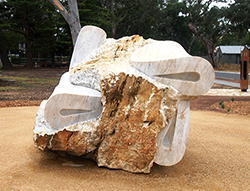 Sculptor: Petre Petrov, Bulgaria.
Sculptor: Petre Petrov, Bulgaria.
Stone: Paris Creek Marble completed in rough and smooth finishes.
Site: Meadows War Memorial Park, Meadows Road, Meadows.
Artist’s comment: ‘The sculpture gives the idea of the “life” in a piece of stone from which the planet’s history is stamped. The hard stone we see now was once full of life and we are still able to see fossils of different bizarre creatures that lived on this place millions of years ago’. (Photo 415058)
12 Journeys
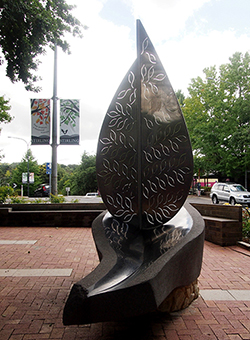 Sculptor: Jocelyn Pratt, New Zealand.
Sculptor: Jocelyn Pratt, New Zealand.
Stone: Black Granite completed in polished and honed finishes and featuring a centrally mounted stainless steel sail.
Site: Corner of Druid Avenue and Mount Barker Road, Stirling.
Artist’s comment: ‘A leaf boat - the journey of change, caring for our environment. Recognising the need to plant local native trees and plants, providing wildlife habitats and improving water and air quality’. (Photo 415059)
13 Hydris
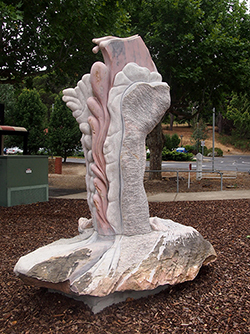 Sculptor: Xavier Gonzalez, France.
Sculptor: Xavier Gonzalez, France.
Stone: Macclesfield Marble featuring a discrete pink layer which is central to the sculpture.
Site: Gawler Street, Mount Barker.
Artist’s comment: ‘Hydris is strong, elegant and sober. The subject is life. It is an organic language, a language with cells. I have tried to feel the magic of life in the stone. Maybe one day I will succeed ...’ (Photo 415060)
14 Cosmic Connections
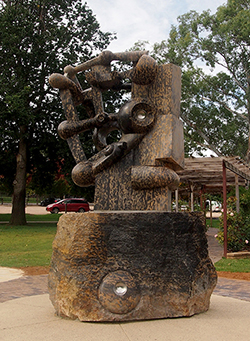 Sculptor: Jhon Gogaberishvili, Georgia.
Sculptor: Jhon Gogaberishvili, Georgia.
Stone: Sellicks Hill Marble completed in polished and smooth finishes on a rough and honed base featuring a sphere of Black Granite with stainless steel.
Site: Keith Stephenson Park, Mount Barker.
Artist’s comment: ‘There was neither time nor space before the universe was created. The whole universe was created after a big explosion and is full of planets and galactica, which move regularly and influence each other. It happened millions of years ago yet this regulation does not change. There is some divine force that makes unification, the universe’s secret support’. (Photo 415061)
15 Splash
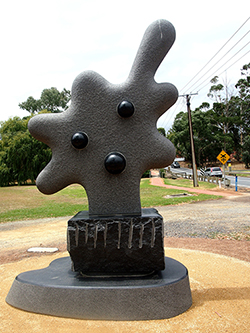 Sculptor: Sakari Peltola, Finland.
Sculptor: Sakari Peltola, Finland.
Stone: Black Granite featuring honed, rough hatched, smooth and polished finishes. The pedestal has been left as it was drilled prior to removal from the quarry floor.
Site: Willow Park, Little Hampton.
Artist’s comment: ‘A tiny drop in time. One fast passing moment. Beginning of life. Frozen forever still. Splash of life. Splash of joy’. (Photo 415062)
16 The Key to the Heart of Mt Torrens and the Birdhouse
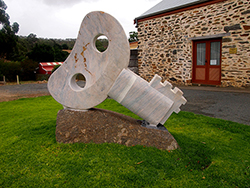 Sculptor: Canan Sönmezdağ Zöngür, Turkey.
Sculptor: Canan Sönmezdağ Zöngür, Turkey.
Stone: Mount Torrens Marble on a base of Black Granite.
Site: 19 Townsend Street (Onkaparinga Valley Road), Mount Torrens.
Artist’s comment: ‘I like to underline tiny details in our life. They connote small objects we unconsciously overlook, and to which we attribute little meaning, ignoring the big messages they carry ... like the key ...’ (Photo 415063)
References
Hiern MN 1959. Marble deposit—near Mount Torrens. Mining Review 106:65–66. Department of Mines, South Australia.
For more information, contact:
Adelaide Hills International Sculpture Symposium www.adelaidehillssculpture.com.au
Includes videos of the sculptors sharing their methodology to create form when sculpting.
Joanne Hough
Joanne.Hough@sa.gov.au



